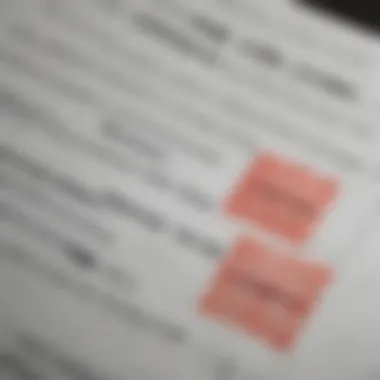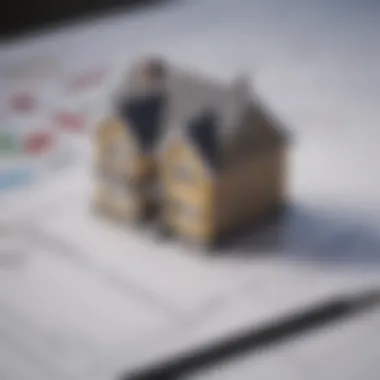Securing Loans for Foreclosed Properties: A Guide


Intro
Purchasing a foreclosed home can be a double-edged sword. At first glance, it might seem like a golden opportunity to snag a property at a bargain price. However, the reality is often far more complex. Jumping into the foreclosure market without a solid game plan can lead to pitfalls that might leave one financially stranded.
Understanding the nuances of the loan process for foreclosures is crucial for anyone looking to invest. This journey involves not only familiarizing oneself with specific financial terminologies but also navigating a web of lender criteria, inspection requirements, and market dynamics. Each step of the way, potential buyers must be equipped with the right knowledge to make informed decisions.
In this article, we will guide you through the intricacies of obtaining a loan for foreclosed homes. We will dive into key investment terminology, offer expert advice, and ultimately empower you with the insights you need for successful investment. Let's chart a course through the loan process for these unique properties, ensuring that you can approach each decision with confidence and clarity.
Investment Terminology
Key Definitions
Before diving headfirst into the sea of foreclosures, it’s essential to grasp some key terms that will frequently come up during the loan process. Knowing this vocabulary can significantly enhance your understanding and give you an edge.
- Foreclosure: This occurs when a lender takes possession of a property due to the homeowner's failure to maintain mortgage payments.
- REO (Real Estate Owned): Properties that are owned by lenders, typically following a failed foreclosure auction.
- Short Sale: A sale in which the property sells for less than the remaining mortgage balance, subject to lender approval.
Familiarizing yourself with these definitions serves as the foundation for navigating the often murky waters of real estate investment.
Commonly Used Terms
In addition to key definitions, there are commonly used terms that can pop up throughout the loan process. Here are a few to keep in mind:
- Loan-to-Value Ratio (LTV): A figure representing the ratio of a loan to the value of the property, which lenders often use to assess risk.
- Pre-approval: A preliminary evaluation from a lender indicating how much money you might borrow based on your financial situation.
- Down Payment: The amount of money a buyer pays upfront when purchasing a home; often required to secure a loan.
Grasping this terminology will not only bolster your confidence but also streamline conversations with real estate agents, lenders, and inspectors.
Expert Advice
Investment Strategies
When it comes to securing a loan for purchasing a foreclosed home, having a well-thought-out strategy can be your ultimate armor against potential setbacks. Consider these strategic approaches:
- Perform Comprehensive Research
- Build a Strong Financial Profile
- Consider Diverse Financing Options
- Look into the history of the property, neighborhood trends, and potential repairs that may be needed.
- Ensure your credit score is in good standing, and gather documentation that showcases your financial stability.
- Investigate different types of loans available, such as FHA 203(k) loans, which cater specifically to properties needing renovations.
Risk Management Tips
Investing in a foreclosed home undoubtedly comes with risks. Here are a few practical tips to mitigate those risks:
- Thorough Inspection: Always get a complete inspection before finalizing a purchase. Hidden issues can lead to significant costs down the line.
- Budget for Contingencies: Set aside a portion of your budget for unforeseen expenses, which can often arise with foreclosures.
- Stay Updated on Market Conditions: Keeping an eye on housing market trends can help in making educated offers and avoiding overpaying.
"In real estate, knowledge truly is power. Equip yourself thoroughly to navigate the complexities deftly."
With these strategies and tips at your fingertips, you can feel more prepared and less overwhelmed by the prospect of buying a foreclosed home, turning what may seem like a daunting task into a well-orchestrated investment journey.
Understanding Foreclosed Properties
When embarking on the journey of purchasing a foreclosed home, it is essential to grasp what "foreclosure" actually means. Understanding this aspect sets the stage for understanding the entire process, ensuring you can navigate it with confidence. Foreclosed homes can be appealing, often appearing at lower prices, but they come with a unique set of characteristics that differ from traditional real estate transactions. Here, we will delve into the definition and characteristics of foreclosures, provide insights on the foreclosure process itself, and weigh the benefits against the risks associated with buying such properties.
Definition and Characteristics
Foreclosed properties are homes that have been repossessed by lenders after the previous owners failed to keep up with mortgage payments. At-its-core definition aside, there are several characteristics that make foreclosures distinct:
- Ownership: After defaulting on payments, the lender, usually a bank, takes ownership through a legal process. This is important because it signifies a shift in responsibility.
- Pricing: One notable feature is that these homes can often be priced lower than their market value. While this might seem like a golden opportunity, it's essential to understand why the price is reduced.
- Condition: Many foreclosed homes may be sold "as-is," meaning they could require considerable work or renovations. Understanding this characteristic is vital for prospective buyers.
- Time on Market: Properties that have gone through foreclosure may linger on the market longer than traditional sales. This might give buyers an edge in negotiations.
By grasping these characteristics, buyers can approach the purchase process with a clearer perspective on what to expect.
The Foreclosure Process
The foreclosure journey typically rolls out in several stages, which are critical for anyone looking to acquire these properties. Understanding each step can help you sidestep pitfalls:
- Notice of Default: When homeowners begin to miss payments, the lender issues a notice. This is the trigger point in the process, marking the start of legal proceedings.
- Public Auction: If the default isn’t rectified, the property is sold at a public auction. Only buyers who can pay in cash or via a specific type of financing typically participate.
- Real Estate Owned (REO): If the home does not sell at auction, it becomes an REO property, meaning the bank owns it and will likely list it for sale.
- Offer Acceptance: Potential buyers may make offers on these properties, which must be approved by the lender. This stage involves negotiations and possibly waiting for bank responses.
Overall, understanding this process demystifies the purchase of a foreclosed home, paving the way for strategic bidding and effective negotiation.
Benefits and Risks of Buying Foreclosures
Diving into the waters of foreclosures can yield financial rewards, yet it’s not without its fair share of challenges. Here are some of the benefits and risks to consider:
Benefits:
- Lower Purchase Price: One of the most enticing advantages is the potential for substantial savings compared to traditional home prices.
- Equity Gains: By obtaining a property below market value, there’s an opportunity for building equity quickly, especially in an upward-moving market.
- Investment Potential: Many buyers view foreclosures as opportunities for investment, whether through renovation and resale or as rental properties.
Risks:
- Property Condition: Since many foreclosures are sold as-is, buyers often face unexpected repair costs that can escalate the overall expenditure.
- Complexities in Buying: The foreclosure process can be complicated and laden with red tape, especially if multiple parties are involved or if lengthy negotiations are necessary.
- Market Fluctuations: As with any real estate, the market can be unpredictable, leading to potential losses if conditions turn unfavorably post-purchase.
Insightful takeaway: It’s crucial to weigh these benefits and risks carefully. Knowledge of the unique landscape of foreclosures equips buyers to make informed decisions while enhancing their chances of a successful investment.


Loan Options for Foreclosed Homes
When stepping into the market for foreclosed homes, understanding the available loan options is crucial. The uniqueness of these properties often necessitates alternative financing approaches. Buyers need to grasp each type of loan to determine which aligns best with their financial situations and long-term goals. Choosing the right loan can mean the difference between securing a home at an appropriate price and facing an uphill battle due to unfavorable terms or unnecessary scrutiny.
Conventional Loans
Conventional loans are perhaps the most traditional form of mortgage financing. These loans are typically not insured or guaranteed by a government entity, which separates them from FHA and VA loans. Banks and credit unions are the major players in this arena.
One significant advantage of conventional loans is flexibility. Buyers can often choose between varying term lengths, such as 15, 20, or 30 years. However, these loans also come with stricter credit score requirements and often expect a bigger down payment compared to government-backed options.
Another point to consider is that while interest rates can be competitive, they fluctuate based on market conditions and borrower qualifications. Therefore, it’s wise to shop around among lenders for the best rate. Additionally, they might require private mortgage insurance (PMI) if you put down less than 20%, a factor you'd want to factor into your overall cost.
FHA Loans
FHA loans, backed by the Federal Housing Administration, offer a lifeline for many buyers, specifically those with less-than-perfect credit. With a minimum down payment of only 3.5%, these loans make purchasing a foreclosed home much more accessible for first-time buyers and those who may not have a substantial amount saved up.
This type of loan has its own sets of restrictions too. For instance, the property must meet specific FHA safety and livability standards. That might be tricky with some foreclosures that could need significant repairs or updates. Also, the upfront mortgage insurance premium (MIP) adds to the initial costs, but on the flip side, monthly premiums may be lower than PMI.
It's essential to look closely at your financial situation and future plans. If you see yourself needing to renovate extensively, weighing the costs of an FHA loan versus other options is crucial.
VA Loans
For eligible veterans and active military personnel, VA loans represent one of the most favorable financing options available. These loans come with several outstanding benefits like no down payment requirement and zero PMI, making them quite appealing.
However, not all properties qualify for VA loans. Like FHA loans, the property must satisfy minimum property standards. Given the potential state of foreclosed houses, those conditions can prove tricky.
In addition to saving on upfront costs, VA loans often feature lower interest rates, and the overall borrowing process tends to be more streamlined. If there's a VA loan in the realm of possibility for you, it's recommended to explore these avenues thoroughly.
Hard Money Loans
When conventional lending routes seem like a pipe dream, hard money loans can step in as a feasible alternative. These loans are typically provided by private investors or companies rather than banks. They're more flexible than traditional loans, but often at a price—namely, higher interest rates and shorter repayment terms.
One of the primary perks of hard money loans is the speed of funding. If you're eager to snag a property before someone else does, these loans can close much faster than their conventional counterparts. However, the costs can be steep, and if you're not careful, they can quickly eat into your profits if you plan to flip the property. You must have a solid strategy in place when considering this avenue.
"Having clarity on the loan options available simplifies the process and empowers buyers to make informed decisions that align with their financial goals."
By understanding the ins and outs of these options, investors can navigate the complexities of financing foreclosed homes with greater confidence.
Evaluating Lender Requirements
When diving into the world of financing foreclosed properties, understanding lender requirements is paramount. The lending landscape can be a tricky beast, and each lender may have its own set of criteria. However, there are common factors that most lenders consider, which can significantly influence your chances of getting approved for a loan. Not only does grasping these concepts improve your application odds, but it also equips you with the knowledge to align your financial profile to what lenders seek.
Credit Score Considerations
Your credit score is like your financial report card; lenders sift through it to gauge your reliability. Generally, a score above 620 is often seen as the bare minimum for securing a loan, particularly for foreclosed homes. But don’t think you can skate by with just that—you’ll want to aim higher for the best rates and terms. The range can vary between lenders, and some may even consider factors beyond the numbers.
To enhance your score, you should
- Pay down any outstanding debts
- Ensure bills are paid on time
- Keep credit utilization low
This proactive approach can help set a solid foundation before you even step into the application process.
Debt-to-Income Ratio
The debt-to-income (DTI) ratio is another crucial piece of the puzzle. This metric compares your monthly debt payments to your gross monthly income. A lower DTI ratio signals to lenders that you’re not overextended financially and are more likely to handle additional debt responsibly. A DTI of 43% or lower is typically desirable, but again, the specifics can depend on the lender.
To manage your DTI:
- List all your debts including credit cards, car loans, and any other recurring payments.
- Divide the total by your gross monthly income.
- Consider paying off smaller debts to lower this ratio.
Applying these strategies can help illustrate your financial prudence to potential lenders.
Down Payment Expectations
In many cases, your down payment can greatly influence your loan eligibility and interest rates. With foreclosed homes often falling below market value, you might face different deposit expectations compared to other properties. Generally, standard advice is to aim for at least 20% to avoid private mortgage insurance (PMI). However, some loans, like FHA loans, may only require a down payment as low as 3.5%.
Consider the following factors regarding down payments:
- Type of Loan: FHA and VA loans have lighter down payment requirements.
- Lender Policies: Each lender may interpret guidelines differently; inquire directly.
- Savings: It’s a good idea to save an additional nest egg for unplanned expenses.
Gathering this information ahead of time helps manage expectations and presents you as a well-prepared borrower.
By thoroughly evaluating these requirements, you enhance your chances of getting approved and put yourself on a solid footing for securing the best possible loan terms.
The Importance of Property Inspection
When purchasing a foreclosed home, taking a good look at the property’s condition is not just a smart idea, it’s essential. Think of a property inspection as the first line of defense against unforeseen headaches down the road. Without a thorough inspection, you might as well be buying a boat without checking for leaks. Many buyers underestimate how critical this step is, potentially walking into a financial quagmire filled with structural issues and hidden costs. Evaluating a property thoroughly can save your investment from turning into a money pit.
Identifying Structural Issues
Spotting structural problems is like finding the tip of an iceberg. A lot lies beneath the surface, and often what you can see is just a small portion of the bigger picture. Foreclosed homes may come with existing or hidden defects due to neglect or prior damage. Common structural issues include cracked foundations, damaged roofing, and sagging walls. Identifying these problems early can prevent bigger, costlier repairs down the line.
Here’s a handy list of common issues to look out for during your inspection:


- Foundation cracks: Can indicate significant structural damage.
- Roof leaks: Water intrusion can cause mold and other issues.
- Leaking pipes: Existing plumbing problems may lead to extensive repairs.
- Pest infestations: Termites or rodents could compromise structural integrity.
Increasingly, many home buyers make the mistake of skipping or rushing the inspection phase. This can be akin to plucking a ripe apple without checking for worms. What seems appealing might harbor serious flaws.
Assessing Rehabilitation Costs
One of the key aspects of buying a foreclosed home is understanding the cost of rehabilitation. While many buyers are drawn to the potential savings on the purchase price, they often fail to budget for necessary repairs. A property inspection can help uncover the exact costs associated with making the home livable and compliant with local codes.
Imagine uncovering a faulty HVAC system during your inspection. Repairing or replacing an HVAC unit can gouge your budget. The aim here is to make sure you don't end up in a sticky situation where what you thought was a steal turns out to be a potential financial burden. When assessing costs, consider:
- Immediate repairs: What needs to be done right away for safety?
- Long-term improvements: What upgrades will add value in the long run?
- Potential contingencies: Always plan for the unexpected.
Working with an experienced contractor can provide insights into necessary repairs and associated costs, ensuring you stay on track financially.
Engaging Professional Inspectors
While doing a DIY inspection may seem appealing, the wisdom of hiring a qualified inspector can't be overstated. Professionals bring expertise and an objective eye to the table. They know what to look for and can spot issues that a novice may overlook. A good inspector won’t just point out problems; they provide context, offering insights about the implications of these issues.
Consider these points when selecting an inspector:
- Credentials: Ensure they have the right certifications.
- Experience with foreclosures: Not all properties are the same; specific expertise can matter.
- Comprehensive reporting: Look for inspectors who provide detailed reports with photos.
Engaging a professional does come at a cost, but in the grand scheme, it’s a worthy investment. A thorough inspection can help you avoid bad buys and unexpected repair expenses. It’s about equipping yourself with knowledge before you make one of the largest financial investments of your life.
A well-executed property inspection can be the difference between a home sweet home and an endless cycle of repairs and financial strain.
Preparing Financial Documentation
Proper financial documentation is a cornerstone of securing a loan for a foreclosed home. Lenders need to see more than just a desire to purchase; they want evidence of your ability to manage the financial commitment. In this section, we'll delve into what types of documentation are necessary and how they can sway the lending decision in your favor.
Gathering Necessary Documents
For anyone looking to navigate the loan process, the first step is collecting the right documents. Think of this as laying down a solid foundation before building a house – without it, what can you expect? Here are key documents you’ll need:
- Tax Returns: Typically, lenders ask for two years' worth of tax returns. They want to ensure you're not only making money but also reporting it accurately.
- Pay Stubs: Recent pay stubs (usually the last two or three months) will show your income flow. Lenders like to see consistency.
- Bank Statements: Having at least two months of bank statements provides insight into your spending habits and available savings for potential down payments.
- List of Debts: A clear view of your liabilities helps lenders assess your overall financial picture, including the debt-to-income ratio.
When collecting these documents, keep in mind that being organized can save you a headache down the line. A neat binder or digital folder can really keep things straightforward and accessible.
Demonstrating Financial Stability
Once you've gathered your documentation, the next task is presenting it in a way that showcases financial stability. It’s not about being the richest person in the room; it’s about showing that you can responsibly handle the loan payments.
Here are some tips:
- Consistency is Key: Lenders usually prefer borrowers whose incomes come from stable jobs rather than variable sources. If you’ve switched jobs a lot, it may lead to questions about your reliability.
- Show Savings: A decent amount in savings indicates that you manage your finances well. It also suggests you can handle the down payment and potential repairs that come with a foreclosed home.
- Debt Management: If your existing debts are manageable and don’t consume most of your income, that indicates you're financially savvy. Keeping your debt-to-income ratio low is crucial.
As a side note, consider this: having good credit is like having a golden ticket—it opens doors, and can sometimes even lead to better loan terms.
"Preparing your financial documentation is not just a requirement—it's your ticket to securing that foreclosed gem you've been eyeing."
In summary, the documentation you gather not only meets lender requirements but also forms a narrative of your financial reliability. This can make all the difference when you are ready to submit your application.
Navigating the Application Process
Navigating the loan application process for foreclosed homes isn't just a formality; it's a crucial stage that could make or break your financial investment. Understanding this process helps to alleviate many stresses that come with securing a mortgage for a property that may present unique challenges. Since foreclosures can often be more complicated than traditional home purchases, every step in the application must be carefully considered.
The application isn’t merely filling out a form. It involves extensive communication with lenders, accurate documentation, and a clear presentation of financial history. This process has its nuances, and comprehending them can give you an edge. You want lenders to see you as a responsible borrower, someone who has done their homework.
Completing the Loan Application
When diving into the loan application, precision is crucial. You’ll be asked for various pieces of information like employment history, income sources, and asset details. In the case of foreclosures, lenders will be keen on your financial credentials because they want to ensure they’re making a sound investment too.
Before you even sit down to fill out the application, gather all necessary documents:
- W-2 forms from at least the last two years.
- Bank statements covering recent months.
- Tax returns that provide a clear picture of your income.
- Proof of additional income, if applicable.
To ace the application, accuracy is paramount. Any discrepancies can immediately raise a red flag and delay the process. Whether it’s a typo in your income figure or outdated info on your credit report, these little errors can haunt your application. A proactive approach to checking and rechecking your details can save you a world of trouble down the line.
Understanding Closing Costs
Many buyers overlook the significance of closing costs in the application process, but this can be a costly error. Closing costs include fees related to the mortgage, such as loan origination fees, appraisal costs, and title insurance. These costs typically range from 2% to 5% of the loan amount, and they can add a considerable sum to your upfront expenses.
Here's a breakdown of common closing costs that you might encounter:
- Loan Origination Fees: Charged by the lender for processing the loan.
- Appraisal Fee: Needed to determine the value of the property. This is critical in foreclosures where property values can be complicated.
- Title Insurance: Protects against any potential defects in the title that weren't exposed during the title search.
- Credit Report Fee: Lenders will pull your credit report to evaluate your financial health.
It’s wise to ask your lender for a good-faith estimate of these costs early on. Knowing what to expect can prevent any nasty surprises at closing. Furthermore, some lenders may be open to negotiating these fees, so don’t shy away from asking. Understanding these costs can not only help you budget but also make you better prepared for discussions with lenders.
"Knowledge is power; the more you know about the application process, the less overwhelming it will feel."
Strategies for Securing Approval
Securing a loan for purchasing a foreclosed property isn’t just about filling out an application and crossing your fingers. It goes deeper than that. The strategies you employ can significantly impact your chances of getting the green light from lenders. Understanding these strategies allows you to address potential concerns before they sink your chances and also helps you present yourself as a more attractive candidate for a loan.


When lenders evaluate applications, they're not simply looking for credit scores and income discrepancies; they dive into the nitty-gritty of your overall financial health. By employing robust strategies, you not only bolster your application but also set a solid foundation for potential long-term success in real estate investing.
Addressing Potential Red Flags
One of the first things you need to think about is addressing any potential red flags in your financial history. This could mean a few different things:
- Credit Issues: If your credit score is on the lower end of the scale, it might not just be about late payments. Maybe you have old accounts that have lingered on your report. Getting these sorted out before applying can show lenders you are responsible.
- Inconsistent Income: If your income bounces around like a yo-yo, lenders might worry. You might need to provide additional documentation to demonstrate stability. Pay stubs, tax returns, and bank statements can offer a comprehensive view.
- High Debt Levels: If your debt-to-income ratio is high, lenders may shy away. To counter this, consider paying down high-interest debts before you apply. It’s a simple game of numbers, but it plays a significant role.
By proactively identifying and handling these red flags, you can work to calm lenders’ fears and exhibit a more reliable, trustworthy profile.
Enhancing Loan Affordability
Loan affordability is crucial when applying for a mortgage, especially in the context of foreclosures. When dealing with properties whose values may fluctuate, it's essential to approach affordability strategically.
- Calculate Your Budget: Start by accurately assessing your financial situation. Are you living paycheck to paycheck, or do you have a cushion for unexpected expenses? Knowing how much you can put down as a down payment and what you can afford monthly is foundational.
- Consider Interest Rates: Interest rates considerably affect monthly payments. If you can lock in a lower rate, it will lessen the financial strain. Don’t just stick with the first offer; shop around.
- Explore Assistance Programs: Often, local governments or organizations provide first-time homebuyer assistance programs. These can offer grants or other financial help that can ease your burden, making that loan more affordable.
In weaving these elements into your loan strategy, you’ll craft a narrative that lenders want to hear—one that highlights your preparedness and commitment to managing your investment responsibly.
"The difference between a successful investor and a struggling one often lies in the details they manage before the application is submitted."
By prioritizing the strategies for securing approval, including addressing red flags and enhancing affordability, you not only improve your chances of securing a loan but also set the stage for a successful venture in real estate investments. This groundwork can easily translate into fortified investments as you navigate the waters of buying foreclosed homes.
Understanding Market Conditions
When it comes to purchasing a foreclosed home, grasping market conditions is not just a nice-to-know; it’s a must-know. Real estate is often described as being localized, which means that what might be hot in one neighborhood could be a complete dud just a few blocks away. Being in tune with local market trends can make the difference between landing a great deal or stretching your budget unnecessarily.
Understanding market conditions gives buyers insight into pricing, availability, and the overall demand for properties. It enables potential buyers to make informed decisions based on data rather than gut feelings. If a buyer can analyze trends effectively, they can predict future movements in the market, allowing them to snag a foreclosure just as values are about to rise.
Analyzing Local Real Estate Trends
Delving into local real estate trends involves looking at various data points such as average home prices, the number of homes on the market, and how long homes are typically listed before being sold. Here are some of the critical factors to consider:
- Historical Prices: Check how prices have changed over the past several years. If prices have steadily increased, that might signal a healthy market.
- Inventory Levels: If there are fewer homes available, it often means competition is high, and prices may go up. Conversely, a surplus could indicate that buyers may have the upper hand.
- Sales Velocity: How fast properties are sold in a given area can be telling. Fast sales might mean high demand and potential bidding wars.
- Demographics: Look into who lives in the area. Changes in population can impact property values long-term.
By piecing together these elements, prospective buyers can better position themselves. Data-driven decisions often yield the best results in real estate.
Timing Your Purchase
Timing is really everything in real estate investing, notably when buying foreclosed homes. There are key times to look out for when it comes to making a purchase.
- Seasonal Trends: Some seasons are better for buying than others. For instance, fall and winter generally offer buyers better prices as sellers often want to offload their properties before the year ends or during the holidays.
- Interest Rate Fluctuations: Keep a close eye on interest rates. When they dip, it becomes cheaper to borrow money, making it a suitable time to jump into the market.
- Economic Indicators: The overall economy’s health will impact the housing market. Economic growth usually boosts prices and gets buyers excited.
In summary, a well-timed purchase can put a buyer at a strategic advantage. They can often secure properties at lower prices if they pay attention to market signals and pick their moment wisely.
"Every market has its rhythm, and understanding that rhythm can be the key to successful home buying."
By integrating all these components, buyers can steer through the loan process for foreclosed homes with a clearer understanding. Knowledge of market conditions doesn't replace the importance of financial planning; rather, it enhances your entire approach.
Post-Purchase Considerations
When you finally get your hands on a foreclosed home, it’s easy to breathe a sigh of relief—after all, the hard part’s over, right? But hold your horses! There’s more to think about after the purchase. The reality is that understanding what comes after securing the loan is just as crucial as the previous steps you've taken. It involves planning renovations, budgeting effectively, and managing your property like a seasoned pro.
Renovation and Remodeling
Once you’ve crossed the finish line on acquiring the property, it’s time to roll up your sleeves and dive into renovations. The state of foreclosed homes can be a mixed bag. Some may just need a facelift, while others could resemble a scene from a disaster movie. This is why it’s essential to prioritize your renovation projects wisely.
Here are a few things to keep in mind:
- Assessing Safety Hazards: Before you even think about aesthetics, ensure that the essentials are safe. Check for structural health and other hazards that might sneak up on you later.
- Cost-Effective Improvements: Focus on upgrades that offer good returns on investment, like modernizing the kitchen or fixing the roof. All that glitters isn’t gold, so don’t waste your bucks on short-term fixes that'll bite you in the end.
- Hiring the Right Professionals: Whether it’s an architect or a contractor, getting professionals who understand the real estate game is crucial. They can help you visualize the potential and avoid common pitfall.
"A well-crafted renovation plan can mean the difference between a worthwhile investment and a financial sinkhole."
Managing Your Investment
Now that your home is starting to look like a real gem, how do you ensure it stays that way? Managing your investment isn’t just about property upkeep; it involves fine-tuning your financial strategy.
- Budget for Ongoing Maintenance: Properties demand upkeep, and foreclosures often require a bit more TLC than standard homes. Set aside money for minor repairs and regular maintenance to keep those bigger problems at bay.
- Document Your Expenses: Keep a solid record of what you spend on renovations and repairs. This not only helps with budgeting but can be handy when tracking your returns when you decide to sell.
- Consider Renting: If living in the property isn’t in the cards long-term, look into renting it out. A rental strategy can help recoup some costs and potentially yield profit. Know your local rental market and price your unit competitively.
Ultimately, the choices made post-purchase can shape your investment’s future. With careful planning, not only can you transform a neglected foreclosure into a cozy nest, but also enhance your financial stability.
End and Key Takeaways
Wrapping up this exploration into the loan process for foreclosed homes reveals a myriad of considerations that all prospective buyers should be mindful of. Successfully navigating this complex terrain is no small feat, yet it can lead to significant financial rewards when approached with the right knowledge.
First and foremost, understanding the unique nature of foreclosures stands as a pillar for making informed decisions. These properties often come at a discount, but are they worth it? It's essential to carefully analyze both the benefits, like lower prices, and the risks, such as extensive repairs. The balance between opportunity and caution cannot be overstated.
Also highlighted is the diversity in loan options available for potential buyers. From conventional loans to specialized FHA and VA loans, each comes with its own set of eligibility criteria and benefits. A firm grasp of these differences can lead to more favorable financing terms, ultimately easing the burden of ownership. Those who invest time in comparing these options tend to discover paths that are more aligned with their unique financial profiles.
Furthermore, we discussed how crucial it is to keep financial documentation in order and prepare for lender scrutiny. Having relevant documents at the ready increases your chances of approval and can speed up the application process. After all, in a competitive market, time is often of the essence.
An area that should never be overlooked is the post-purchase phase. Understanding what it takes to manage a foreclosed investment — whether it's dealing with immediate renovations or long-term property value enhancements — is vital. This aspect of ownership can dramatically affect the eventual return on investment.
Understanding all these aspects provides clarity and confidence. Remember, knowledge is power in the world of real estate.
Recap of Essential Steps
- Assess and Understand Foreclosures: Recognizing both the pros and cons allows you to make informed decisions.
- Explore Loan Options: Get acquainted with different loan types to find what suits your circumstances best.
- Prepare Financial Documentation: Having your ducks in a row when it comes to necessary financial paperwork will streamline the process and ease approval.
- Conduct Thorough Inspections: Be diligent in assessing the property to gauge its true condition and anticipated investment costs.
- Post-Purchase Management: Be ready for renovations and maintenance as part of managing your new asset.
In summary, the journey through financing a foreclosed home is layered with challenges and opportunities. Those who remain diligent and proactive can navigate the process successfully, turning potential risks into a rewarding investment.















